Comparing Synthetic watercolour brushes Part 3
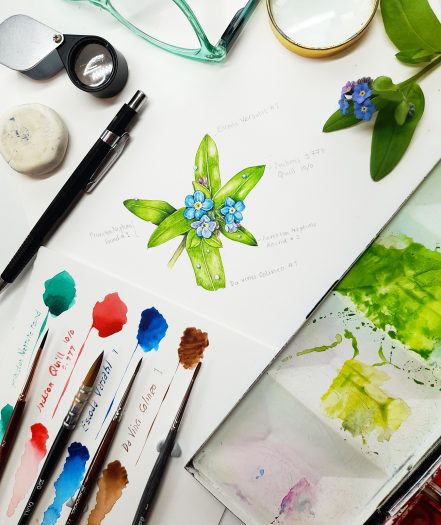
This is the third of my blogs (and films, the one specific to this blog is here) trying to find a good synthetic alternative to my beloved Winsor & Newton sable series 7 watercolour brushes. This time I’m trying out the Princeton Neptune round (Series 4570), Jackson’s Icon synthetic Quill S777 10/0, Escoda Versatil round, and Da Vinci Colineo. For reviews of the previous synthetic brushes I’ve tested please click here (where I also explain why I love my Winsor and Newton sable so much) and here (where I begin my quest for an alternative synthetic in earnest.)
Why look for alternatives?
As a committed vegetarian since the age of 11, I’ve always been a bit bothered that my sable brushes are made from hairs that come from a little weasel. With each passing year, more and more companies are waking up to this need for a reliable and high quality alternative to both sable and squirrel hair brushes. And I’m giving lots of these a try. The brushes I try out are mostly based on reccommendations from my Youtube viewers, and blog readers. Thankyou.
Another reason to look for alternatives is price. I get through one or two Series 7 brushes a month, and my size 1 brushes retail at £28 full price (May 2023). Yes, you can often get them at discount, but all the brushes I’ve trialled here come in at well below £10.
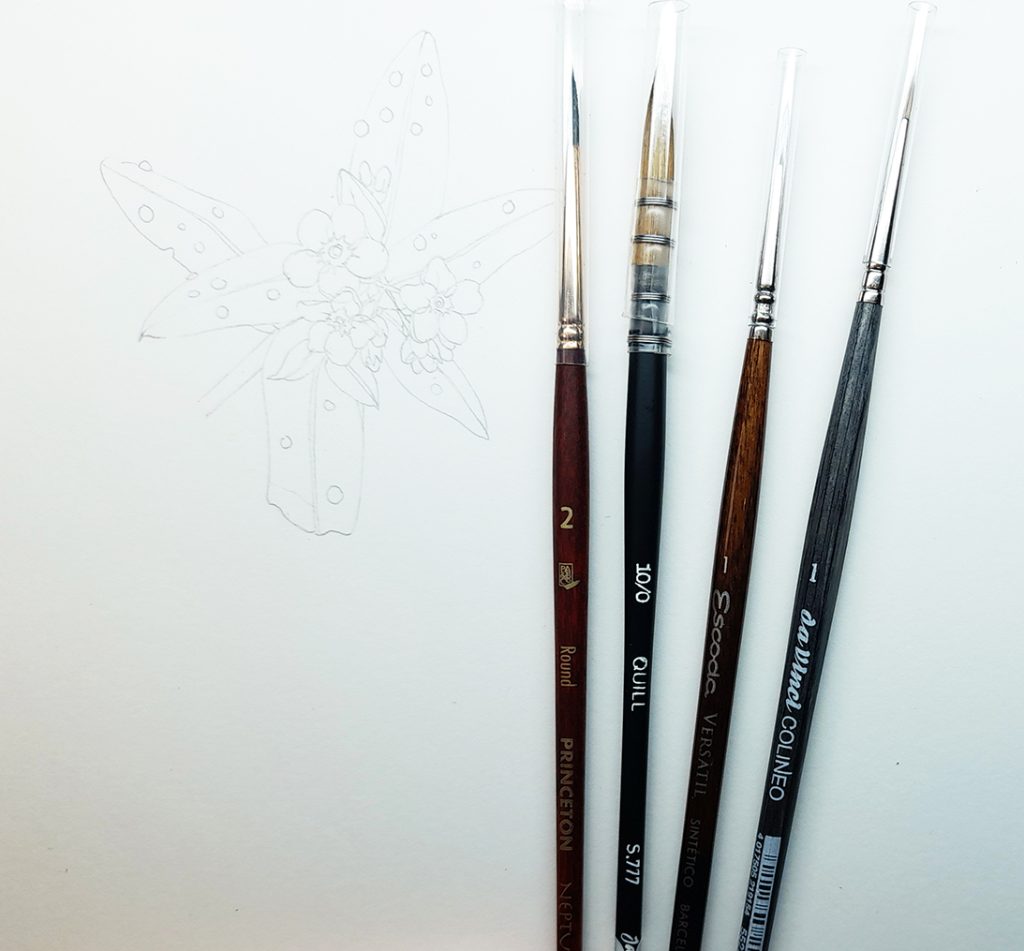
The four brushes Ill be testing today, fresh from their packaging
I’ve sourced all these brushes from Jackson’s art, here in the UK. They have a wide range, and they post their stuff in safe but minimal packaging, all recyclable. Many other suppliers carry them, both here and internationally. Just have a look online. None of the brushes I try, nor Jackson’s Art supplies have given their brushes for free, so this blog is entirely unbiased. Saying that, please remember that choice of brush can be a very personal thing, and just cause I love or loathe a brush doesn’t mean you will agree!
To complete these tests, I use each brush to paint one or two leaves of the forget-me-not; then put them through a “blob test” where they need to deliver blobs of colour, mix these down to watery tints, provide a sharp crisp line, and then I write their names alongside these results…with the brush in question.
Princeton Neptune Round: The new brush
First up, I tried the Princeton Neptune round. It’s a synthetic squirrel, and I had to use a size 2 as no size 1 brushes were in stock. First impressions were good. I was slightly disappointed to see a little hook on the tip as I remove the plastic brush protector, but this didn’t seem to alter the way the brush worked. It’s a good handle length, and the brush isn’t stocky, or long, like a rigger might be.
Princeton Neptune Round: Mixing paint
When mixing paint the brush looked good. It wasn’t too small (meaning it takes ages to get enough of your colours onto the palette) nor too big (carrying too much paint for each brushstroke). The tip held well describe the rather rough treatment I give it during colour mixing.
Princeton Neptune Round: How sharp is that point?
The point of the brush held throughout the painting process, and delivered a truly reliable and crisp line. It was accurate and I soon forgot I was trialling a new brush.
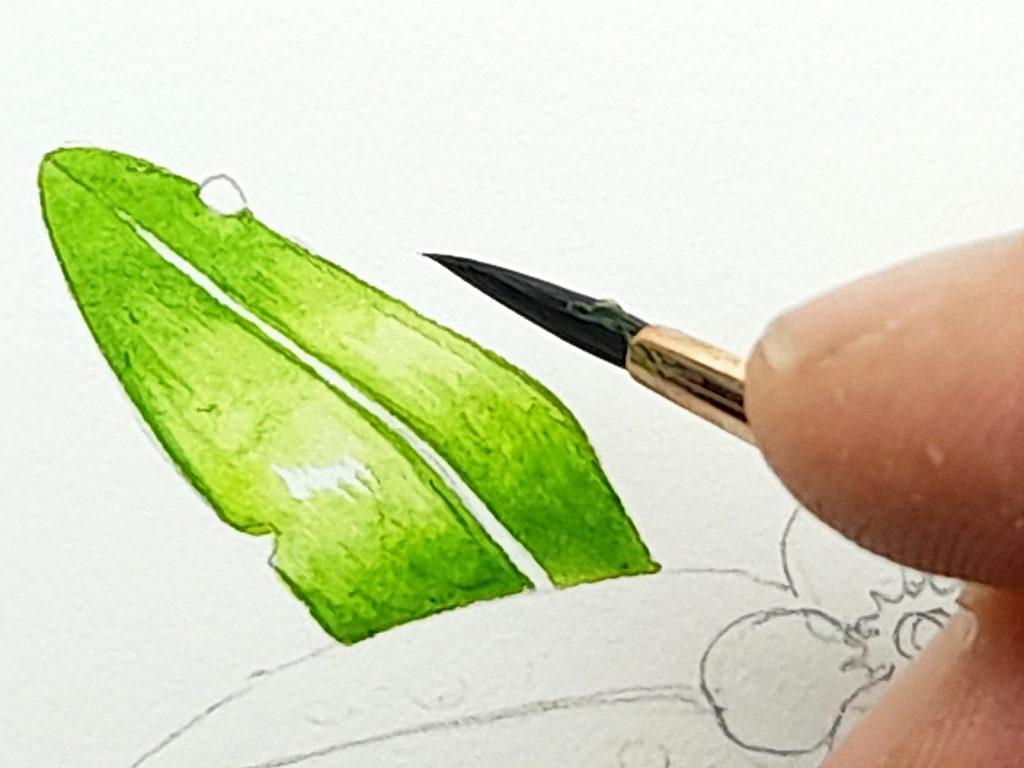
Tip of Princeton Neptune round during painting
In fact, it was so good that once I’d trialled all the other brushes I came back to it and completed the forget-me-not using this brush. And enjoyed it.
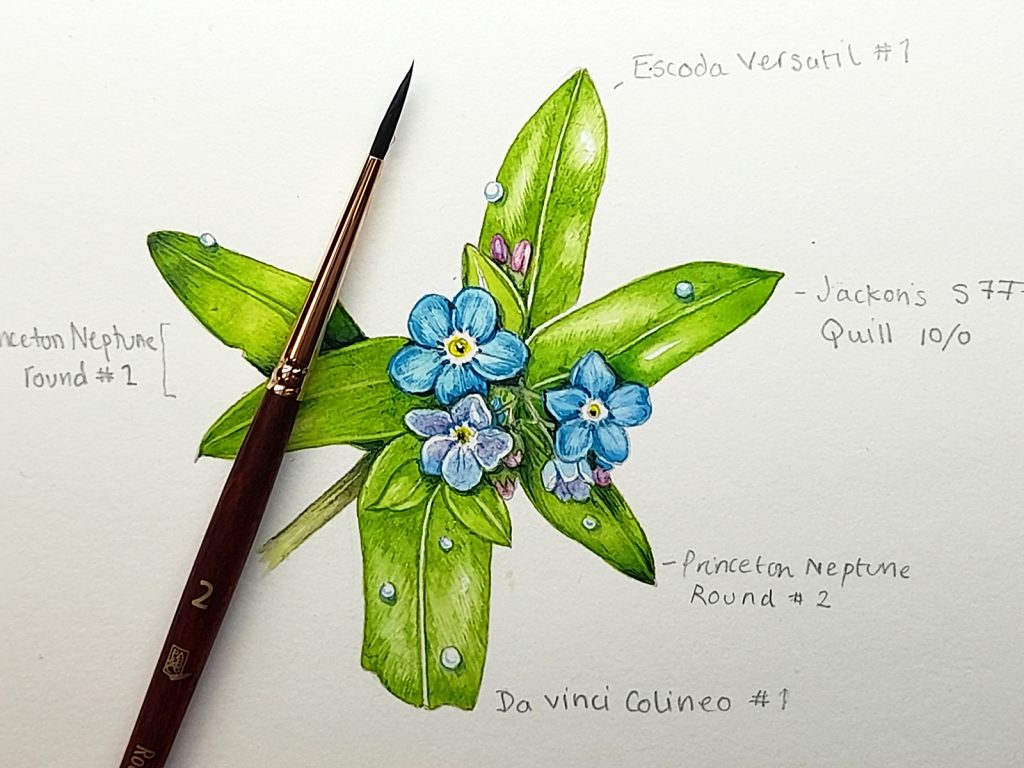
Complete illustration with Princeton Neptune Round brush
Princeton Neptune Round: The Blob Test
This test involves mixing up a big blob of once colour, pulling out as fine a line as possible from it, mixing a tint out to clear water, then writing the name of the brush alongside.
Unsurprisingly, the Neptune Round passed the Blob test with flying colours.
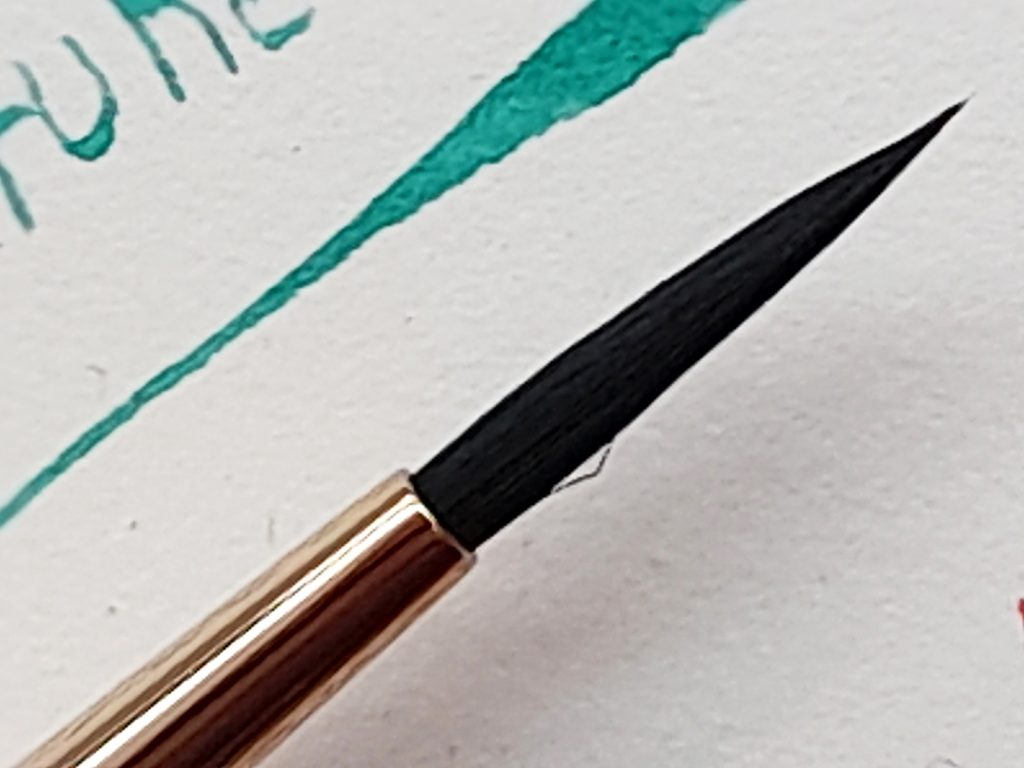
Close up of the tip of the Neptune round alongside blob test
After using the brush for a while it did develop a bit of a kink at its’ tip, but held up significantly better than the other synthetics I’ve trialled. I shall certainly be working with it more often, to see if I can truly use it as a replacement, I’d also be interested to see how a number 1 size brush behaves. This one was a number 2 as the smaller ones were unavailable.
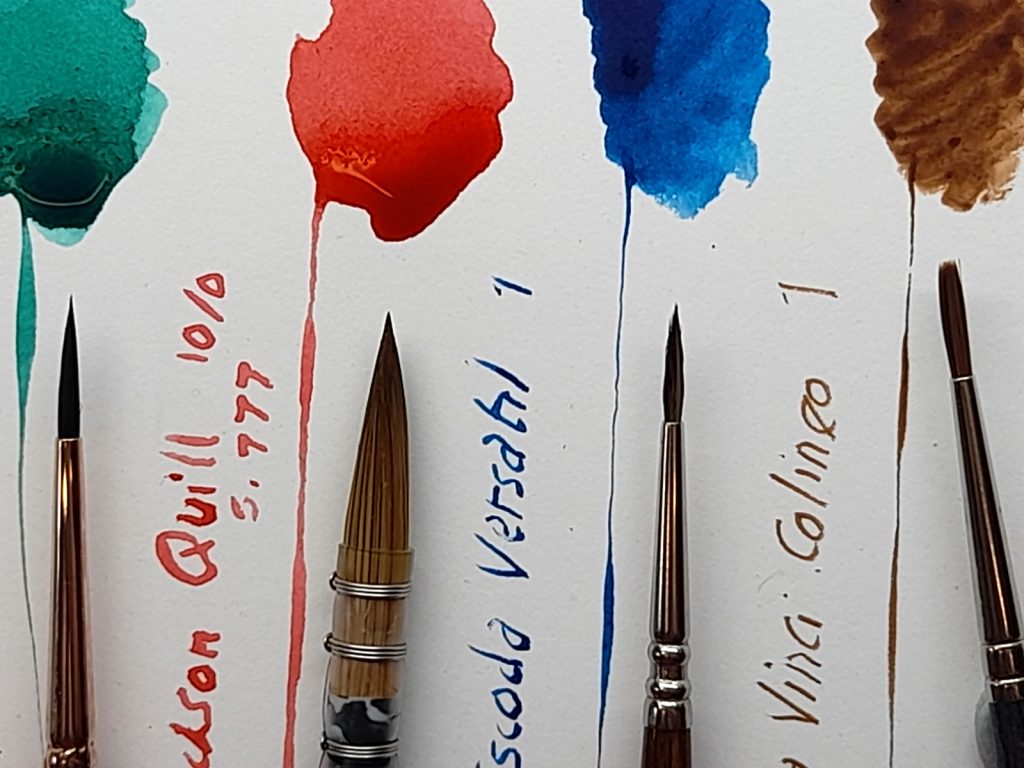
“Blob test” comparison of brush nibs (Neptune on the far left)
Princeton Neptune Round: Conclusion
This brush is one of the most promising I’ve tried so far. I will certainly be trialling it further. It held its’ point, gave a reliably accurate and shaper line, could handle mixing, and didnt degrade over the course of one morning’s painting. At the time of writing, this brush (number 2 size) cost £5.50 from Jackson’s art.
Jackson’s Art S777 Quill: The new brush
Next up is the Jackson’s Icon synthetic size 10/0 quill series 777. I got a bit muddled when I made the accompanying Youtube film and kept saying it was a 10/1 as I think I saw that written on a packing note. Apologies, it is in fact a 10/0. It looks like no brush I’ve ever used before.
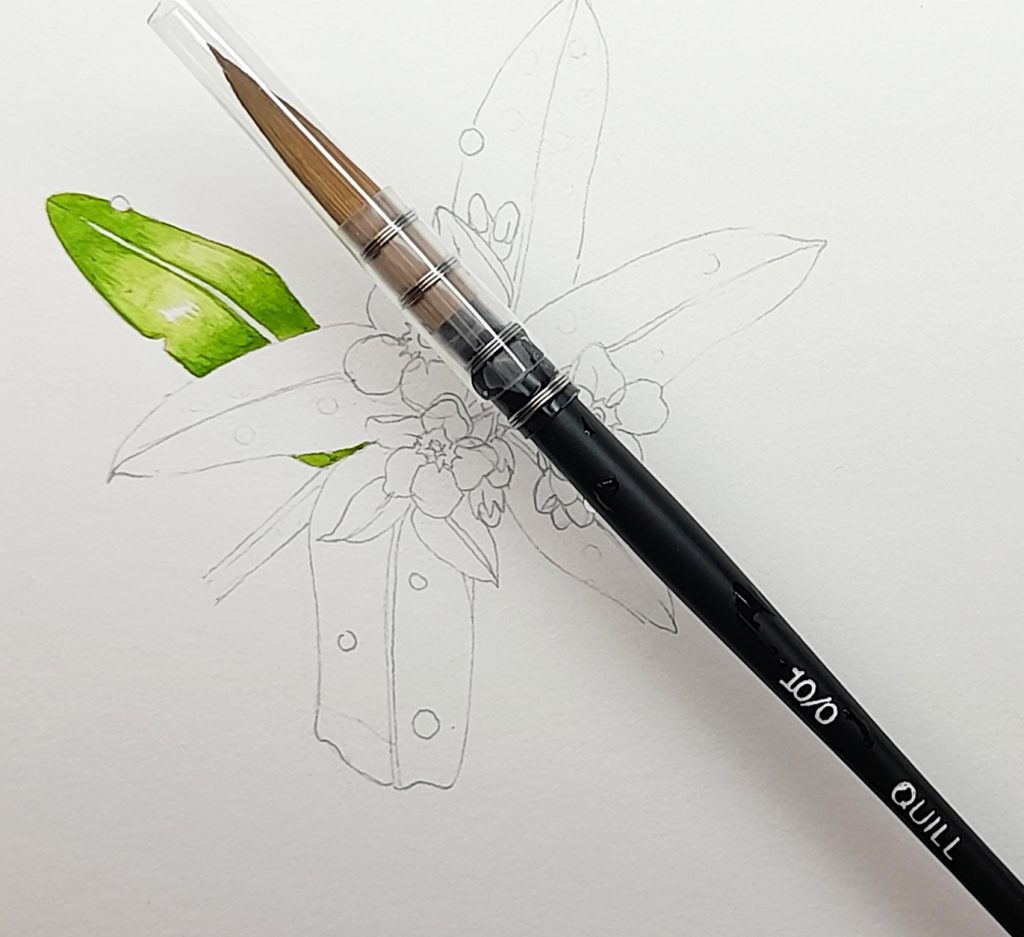
Unused Jackson Quill S777 10/0
It ha such a wide brush head, and is so seemingly big. But the point looks sharp, so I’m willing to try it. However, I was already a little out of my comfort zone…
Jackson’s Art S777 Quill: Mixing paint
I mixed up some fresh green for the forget me not leaves…and the brush swallowed the whole palette full in one easy gulp. Because the brush head is so big, inevitably it’s also very absorbent and thirsty. This was quite a problem for me. I had to re-appraise the amounts of paint I was mixing, and no matter how much of a mix I made, the brush devoured the whole lot in one gulp.

Close up of the unused tip of the Jackson Quill
The other problem came when I rinsed the brush between mixing colours. Because it took up so much paint, it also took a lot more time and effort to clean the brush out. Several times some residual amounts of colour caught me out, and got added into a new colour mix, with unintended results.
The flip side is that if you wanted a full brush and not to keep returning to top up the brush from your palette, this brush would deliver.
Jackson’s Art S777 Quill: How sharp is that point?
Despite looking crisp and sharp, the point of this brush was blunt the first time I applied it to the page. It left thick and unreliable lines, and simply didn’t feel accurate. It’s not like it doesn’t have a point, it does, and in comparison to the broadness of stroke you can get from one stroke, the sharpness is admirable. But for botanical illustration? It didn’t work, at least not for me. The photos suggest it has a pin-sharp point, but I think the issues arise the second you apply pressure to that tip.
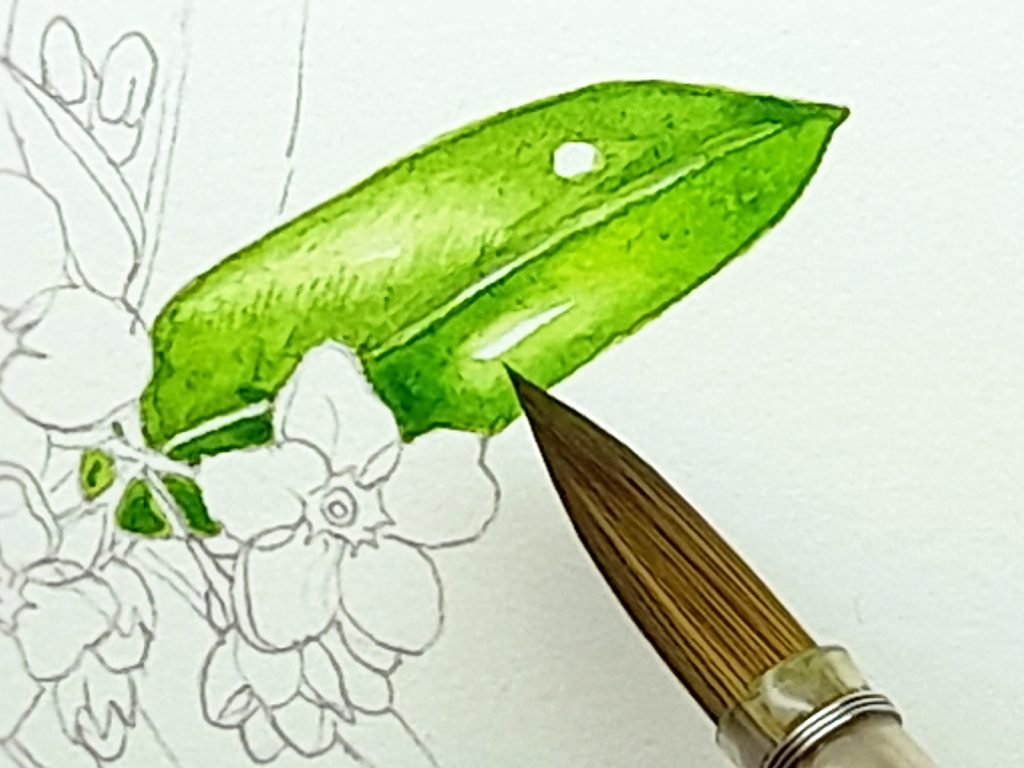
Tip of the Jackson’s S777 Quill
Jackson’s Art S777 Quill: The Blob Test
The brush was excellent at mixing on a large dollop of strong colour, and did an excellent job of mixing down through tints to almost clear water. It also held it’s tip for one straight line. however, when I tried to use that point to write the name of the brush alongside the test blob, the bluntness and lack of accuracy became evident. Again, the photos belie the blunt feel of the nib once in use.
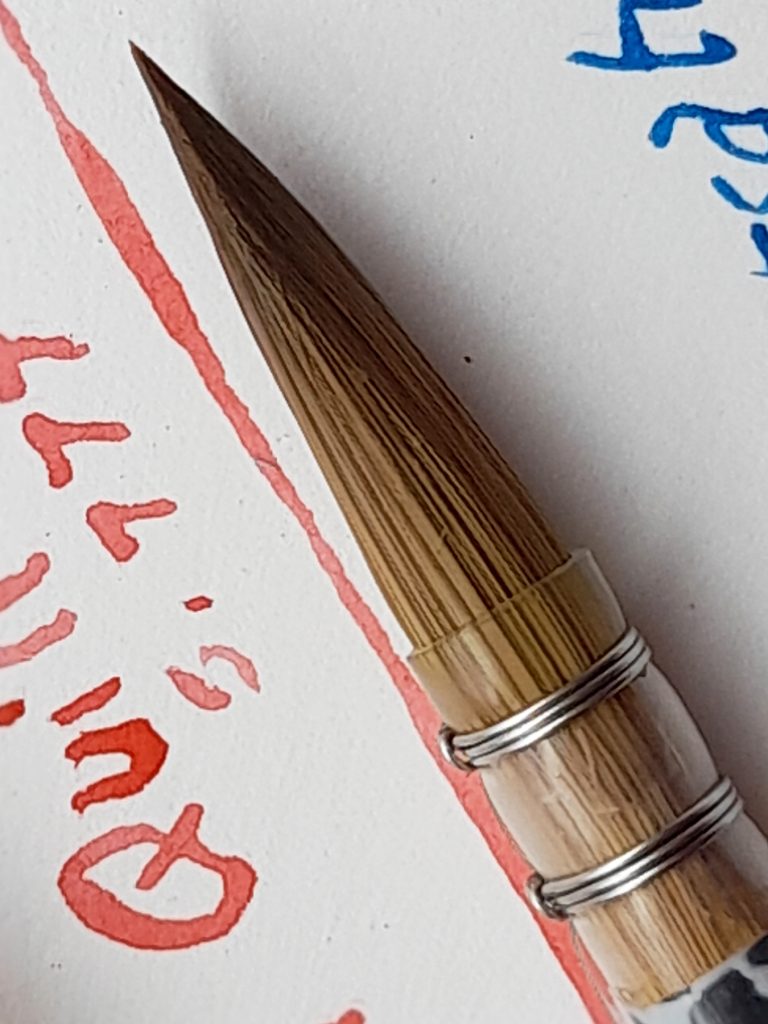
Jackson’s s777 Quill alongside the Blob test
Jackson’s Art S777 Quill: Conclusion
I think this is an excellent brush. It has the ability to hold loads of paint and to deliver a massive range of line widths. if I was a calligrapher, or someone using big expressive brush strokes, I think I’d be in seventh heaven. But I like tiny crisp lines and a reliable smaller brush which doesn’t eat all my paint in one sitting. For my style of botanical illustration, this brush was a complete mis-match, and I shan’t be trying to paint leaves with it again anytime soon. At the time of writing, this brush cost £5.10 from Jackson’s art.
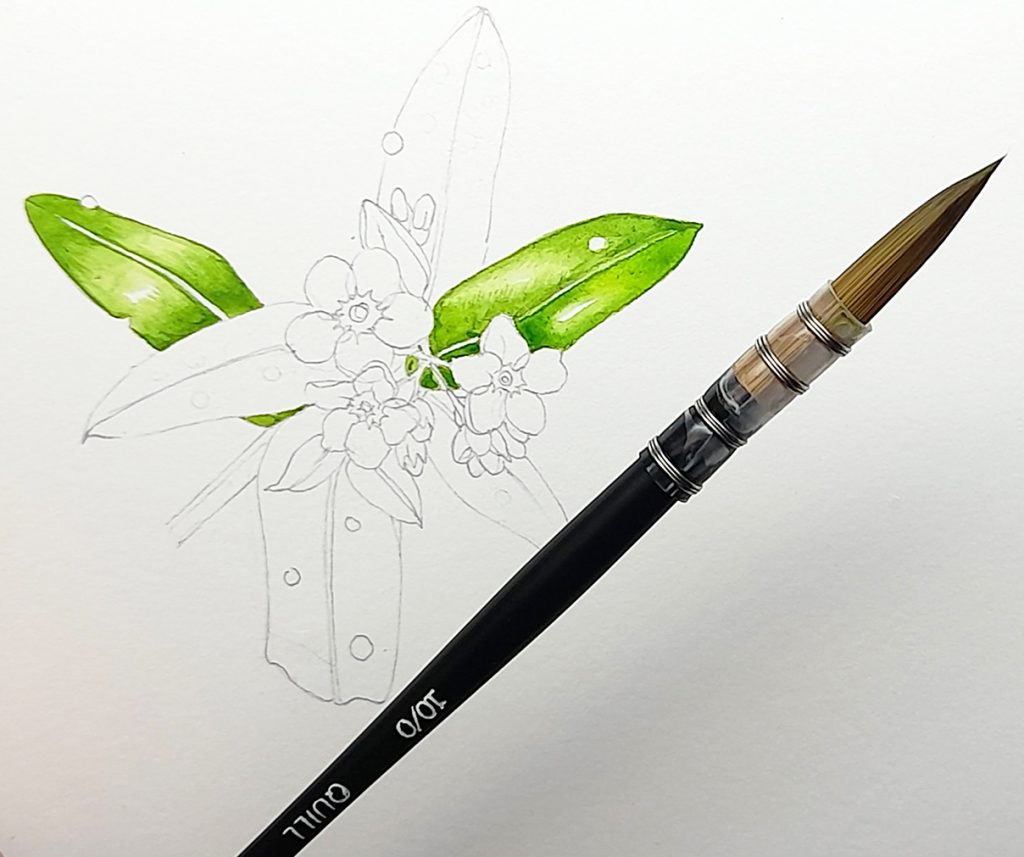
Brush alongside the leaf (top right) it was used on
Escoda Versatil round: The new brush
First impressions of the Escoda Versatil round brush are not good, despite me feeling happy that I was finally painting with a size 1 brush. This range are synthetic sable. The unused point looks rough, and seems to instantly splay when any pressure is applied. The handle and length of the brush and nib is fine.
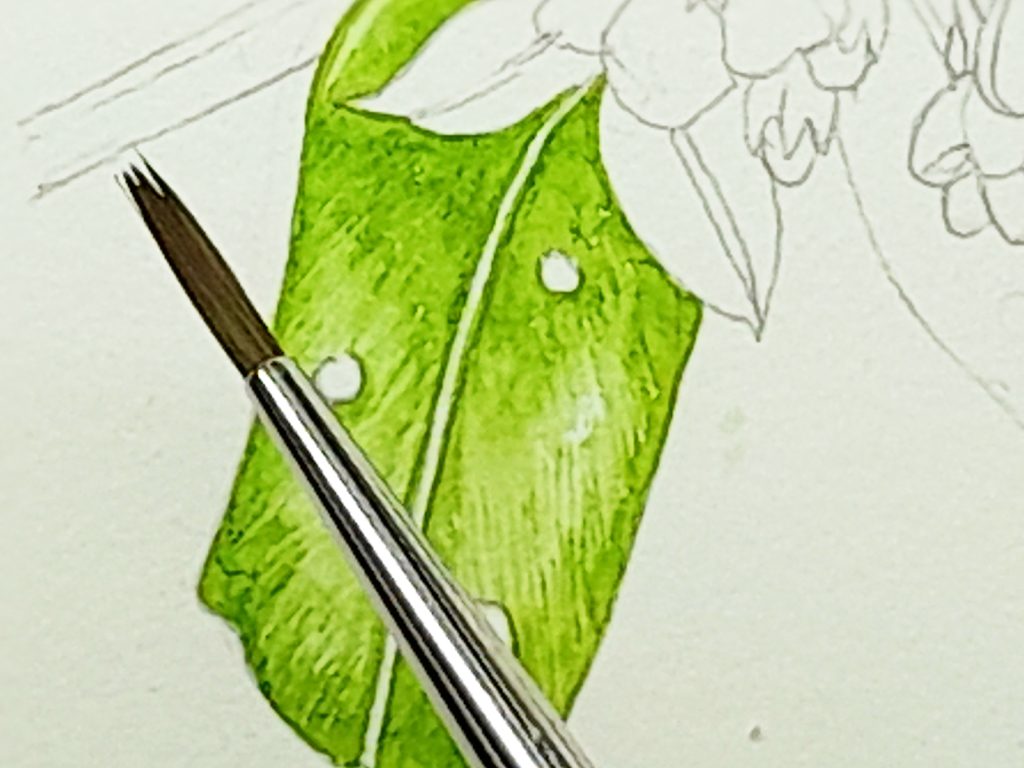
Escoda Versatil round: nib fresh from the nib sheath, after one dip into water
Escoda Versatil round: Mixing paint
When mixing colours, the brush doesn’t swallow up all the colour in the palette. It picks up a good amount of paint from each pan. However, despite repeated attempts at spinnning the brush in the mix, trying to “twist” it into a point, no sharp nib was forthcoming, It remained steadfastedly blunt.
Escoda Versatil round: How sharp is that point?
Interestingly, using the brush was left awful than I feared. The very tip of the brush had one of two rogue hairs working together, and these could deliver a tiny accurate and crisp line. But just behind, less than a millimetre away, is an area of splayed hairs and roughness. I had to concentrate really hard with each and every brush stroke to make sure I didn’t catch the edge of this zone and suddenly thicken my line.
After a while, I found I could paint alright, by using one corner of the brush tip, although I won’t pretend I enjoyed the experience. The brush felt a bit flattened too, almost like I was painting with a corner of the nib. With less than 15 minutes of use, the nib was visibly deteriorating and becoming less and less reliable.
Escoda Versatil round: The Blob Test
The brush delivered a good blob of solid colour to the page, and relying on that apical stray hair, I could get a decent thin line. It also did a good job with the diluting and mixing the blue colour to a paler and paler tint. But the writing was challenging and I’d already fallen firmly out of love with the brush.
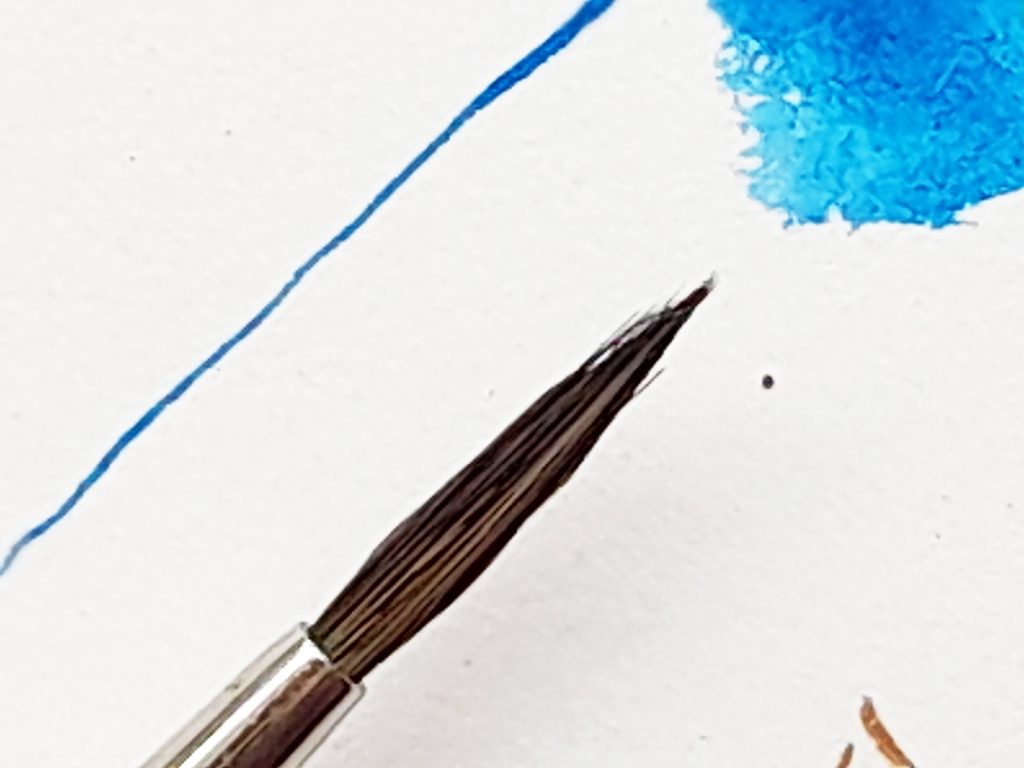
Clos up of the Escoda Versatil round nib showing the rough tip
Escoda Versatil round: Conclusion
Sadly, this brush is a definite no for me. It’s tip was unreliable and scruffy, and only held a crisp line if I relied on two or three loose hairs. It degraded as I used it, and I was very relieved to be finished with it at the end of painting a leaf and doing the blob test. Not one for me. At the time of writing, the Escoda versatil round brush (No 1 size) cost £6.70 from Jackson”s Art.
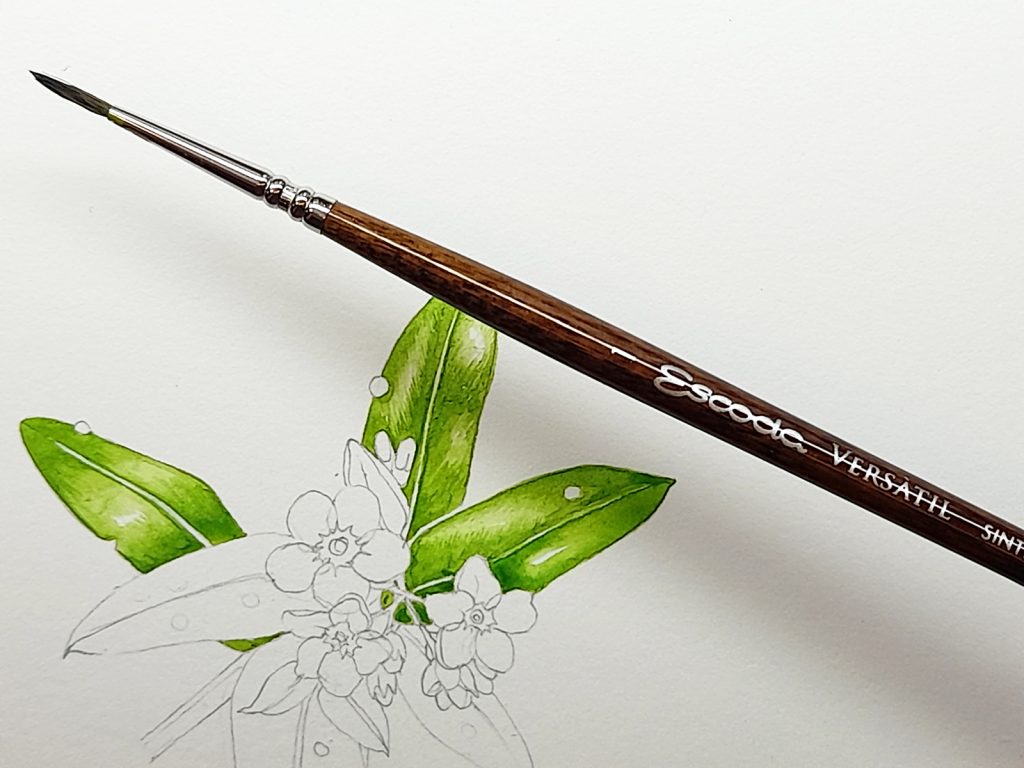
Escoda versatil round 1 whole brush with painted leaf
Da Vinci Colineo: The new brush
The last brush I tested was the Da Vinci Colineo. It’s a synthetic sable, and another number 1 size. My first impression was that the handle is bluntly triangular, something I’m not at all used to in a paint brush. The tip, on removal from its packaging, looks good. I can spot a couple of loose hairs, but on the whole it looks ok.
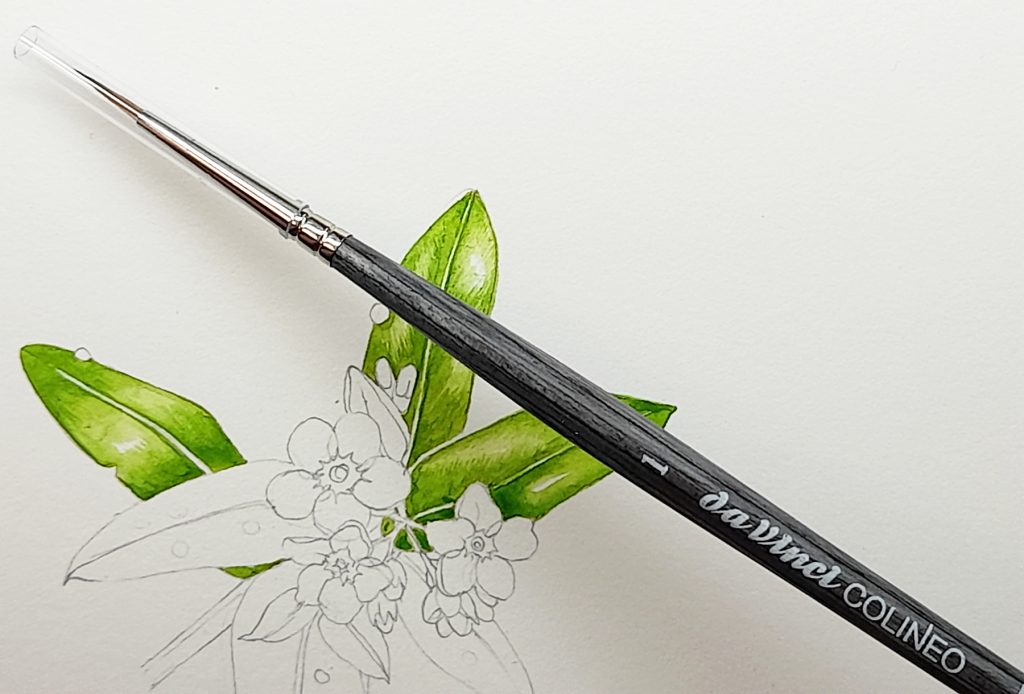
Fresh Da Vinci Colineo brush
Da Vinci Colineo: Mixing paint
The brush mixes paint well. Neither too thirsty nor too small to hold a good amount of colour, it’s easy to mix with and collects the right amount of pigment from the pans.
Da Vinci Colineo: How sharp is that point?
Indeed, it’s the crucial question. How sharp IS that point? In this case, disappointingly, not very. The tip looks flattened, and laterally compressed. It feels more like a brush which has a rectangular shaped head than a round brush (perhaps it is designed to be a little square shaped at the tip, not round?) To get a sharp line, I had to use one corner of the brush point, almost like I was relying on the corner of the brush tip. Using it this way, I could get very accurate crisp lines, which momentarily made me put it as my second favourite (after the Princeton Neptune). But at no point did this approach feel reliable or safe. One false move and the whole flat width of the brush would come into play.
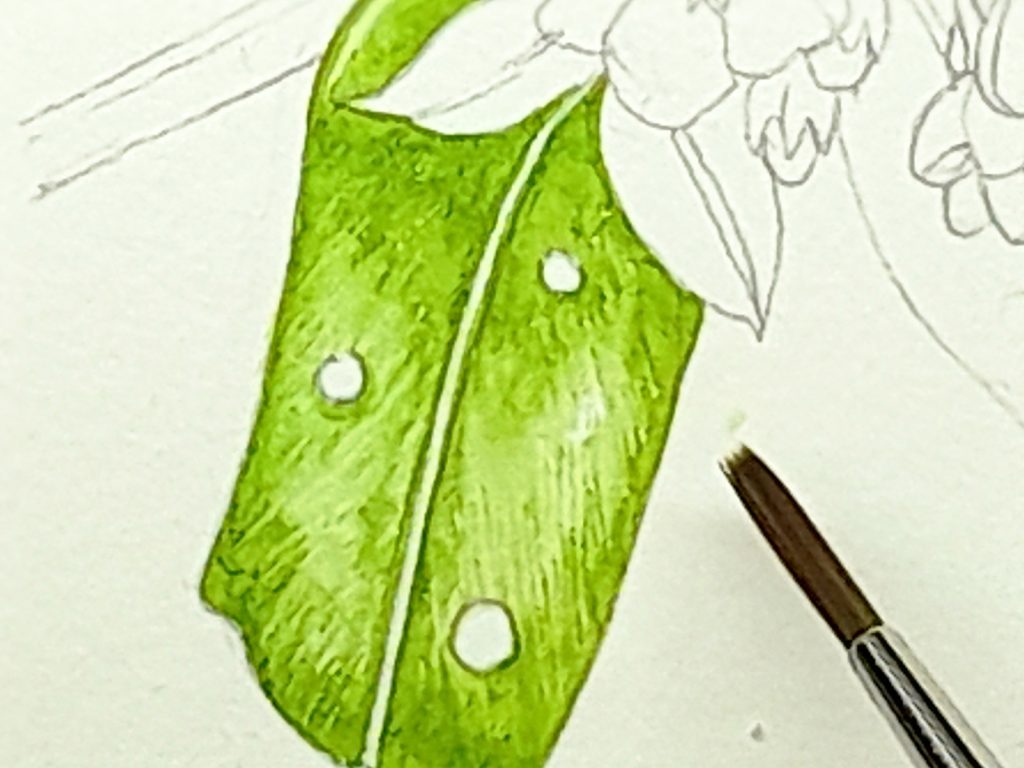
Point of the Da Vinci Colineo
Within ten minutes of use, two hairs came loose. Within 15 minutes the scratching of the hairs was so pronounced that I could hear them on the paper. Not a good sign. When I came to paint the top layers of green, a paler tint, this brush failed me completely. It gave much more paint into the area than I wanted, and ended up swallowing the highlights I’d been planning on leaving white.
Da Vinci Colineo: The Blob Test
In the blob test, the loose stiff hairs and unreliable point showed. Yes, the brush was fine at mixing colours and doing the blob and the tints. But a reliable thin line wasn’t forthcoming, and writing the name of the brush with such a scratchy tool proved awkward. Another one to cross off the list of candidates, alas.
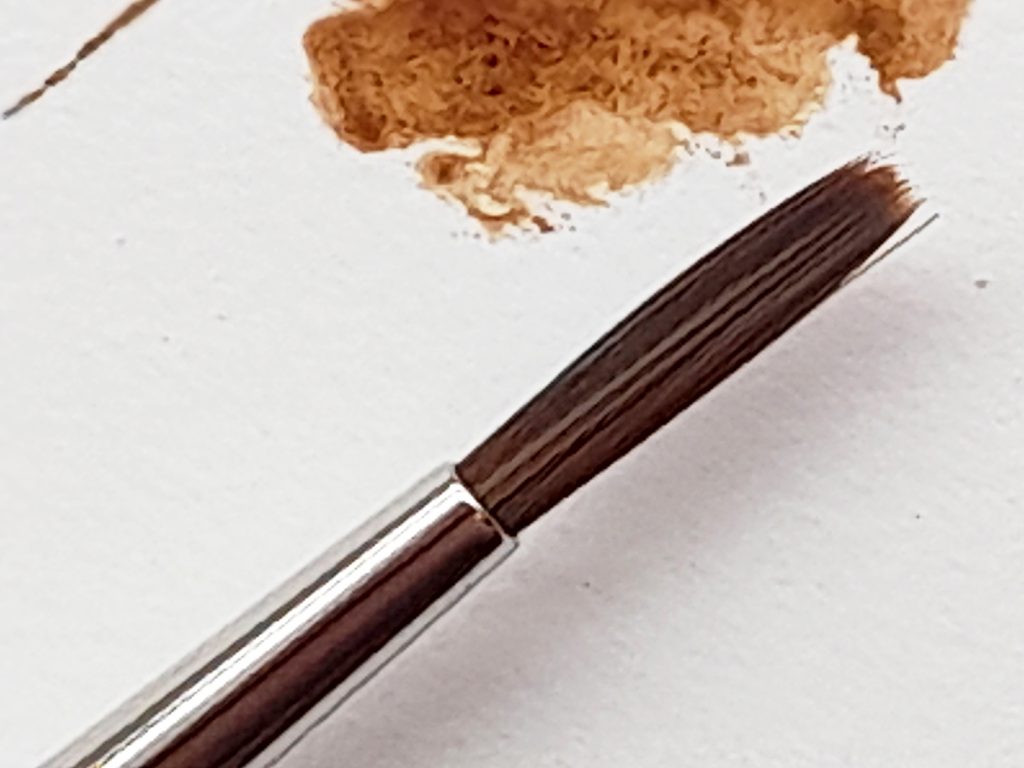
Da Vinci Colineo: Close up of the nib during the Blob test
Da Vinci Colineo: Conclusion
Alas, the Da Vinci Colineo round is another brush I’ll not be using again. With the stiff, scratchy square nib, triangular handle, and stary hairs, there;s no way I could rely on this brush to deliver the consistent accuracy I need for botanical illustration. Currently, this brush retails from Jackson’s art at £6.60.
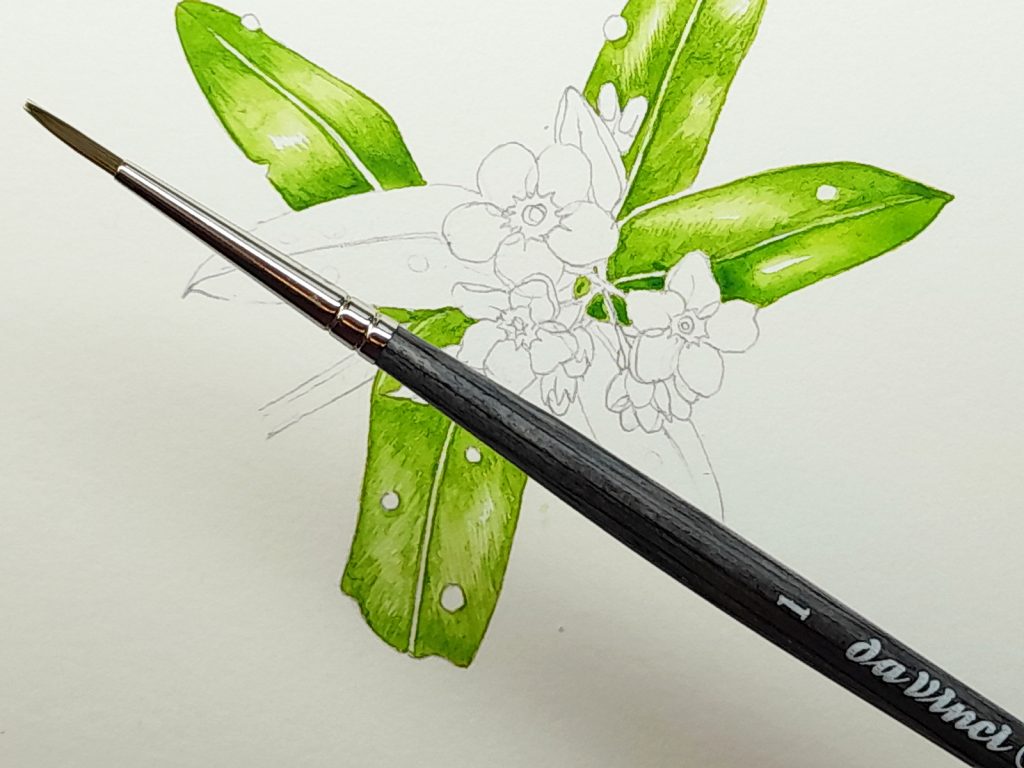
Used Da Vinci brush with the flower.
Overall Conclusion
Rather like the curate’s egg, this batch was only good in places. Princeton Neptune round is a real contender, and I’ll be lining it up along side my other current favourites; namely the Princeton Neptune Script (whose nib was a little too long for me) and the Rosemary & Co. Red dot Spotters. Having used it a little more since the initial test I’m still deciding whether or not to order in another. But it’s looking promising, and I actively enjoyed painting the rest of the forget me not with this brush.
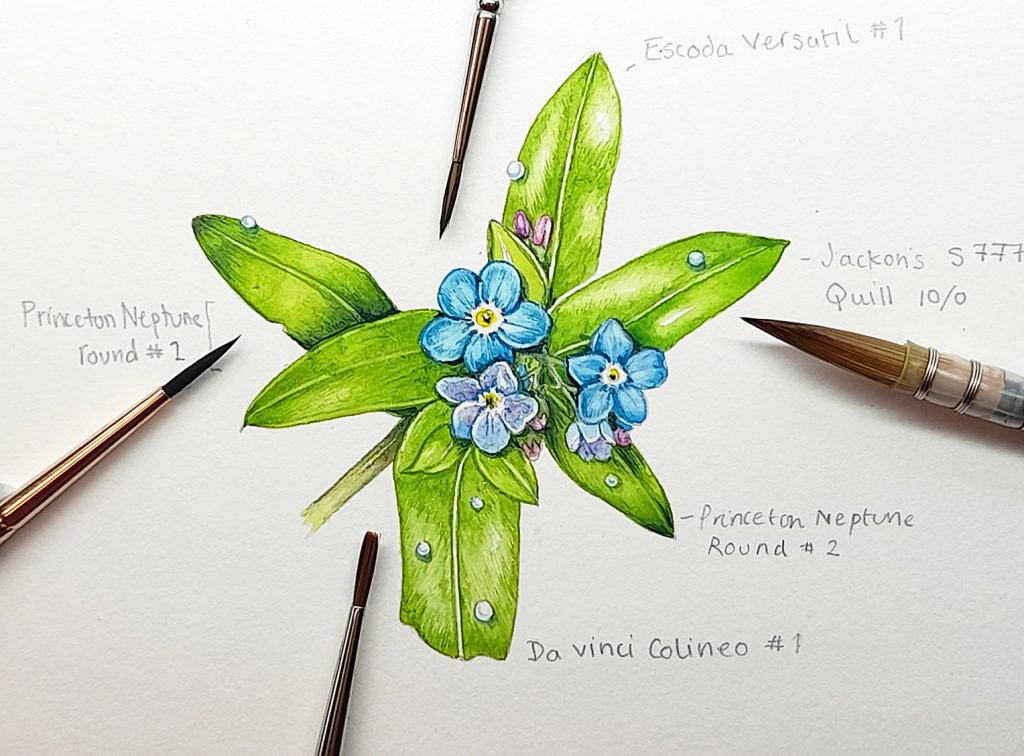
Forget me not with all four brushes alongside the leaves they painted, and annotations
However, the Jackson’s Quill just felt like a brush for a different discipline. And unfortunately the Escoda Versatil and Da Vinci Colineo simply didn’t have the required quality when it come to sharp consistency in the nib.
As I say, all these brushes were bought from Jackson’s Art in the UK. Some are carried by other UK suppliers such as Ken Bromley and Cass Art. Internationally, I’m sure you have your favourite art shops, too.
For now, I’m going to be returning to my Series 7 sable brushes, and trying to use the synthetics alongside them. It’ll be interesting to see how they hold up in a context lasting longer than a few filmed minutes.
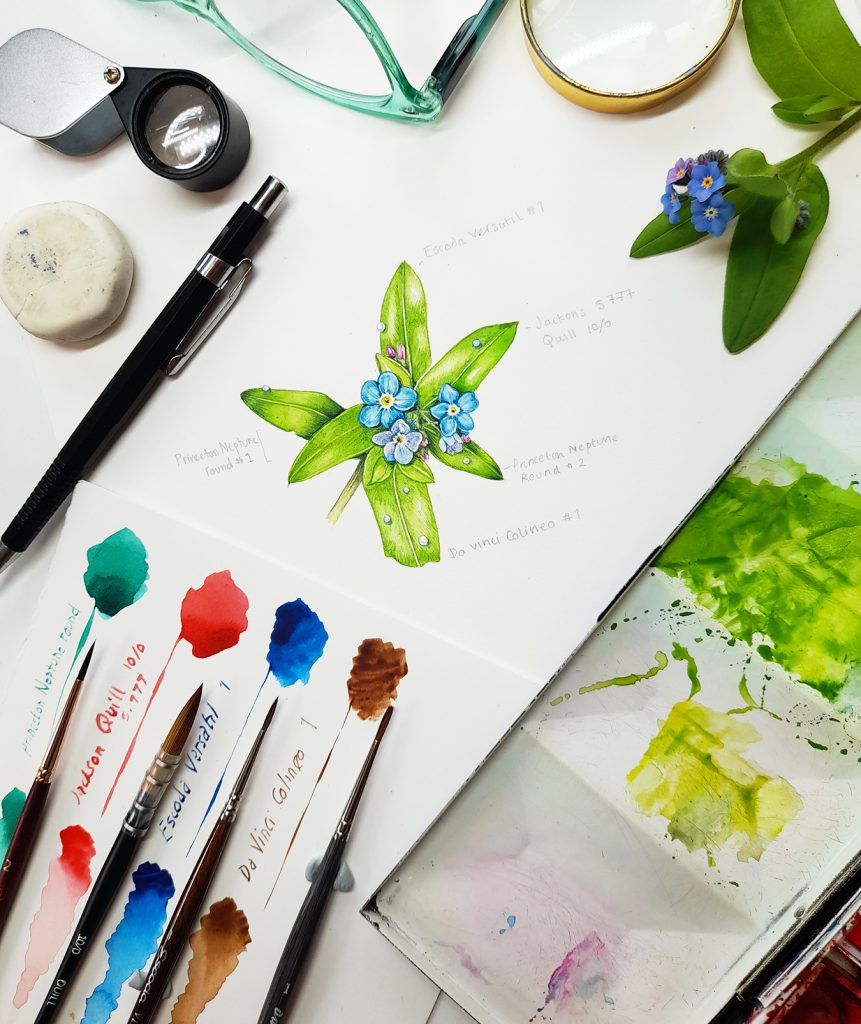
To see these trials as a film, please check out my Youtube film (below)


Try the Escoda Chronos, short handle. Synthetics and sable mix. Also Winsor Newton professional watercolor brush, pointed round that is synthetic. These are great brushes. Love your art work and technique
Hi Cher, I did end up trying the Escoda – the Perla and Prado. Both of which I loved. Thanks for the suggestion.
I think you got a bad brush of the Versatil. My first Versatil pointed round brush was also splayed and didn’t hold a point, I returned it. I’ve had a much better experience with the replacement.
Although, I tend to use the larger Versatil and just use real Kolinsky Sable for smaller sizes
Hi Michael
That’s quite possibly true. Its so hard to know if you get a dud brush or if the brand is at fault. That’s really interesting that you had a poor one then a good one. Thanks for sharing your experience, maybe I should give Versatil another go. Yours Lizzie